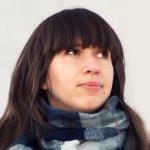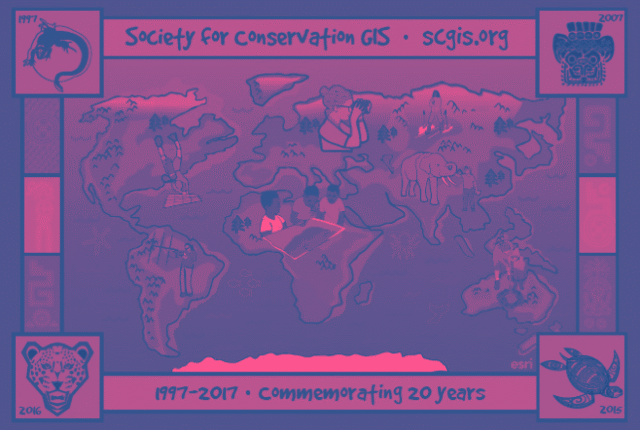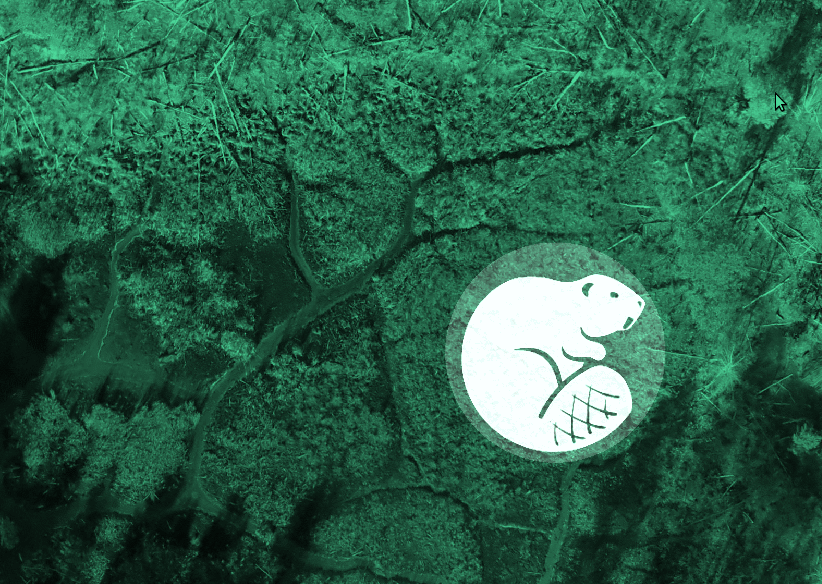
Ефективна робота установ природно-заповідного фонду України потребує постійного картографічного супроводу, використання даних дистанційного зондування, аналізу даних біорізноманіття, рекреаційного використання та багато іншого. Розпочинаючи працювати у національному парку, ми з Антоном Біатовим (наразі ГІС-фахівець у природоохоронній сфері) потребували нових знань для роботи з просторовою інформацією. Де їх узяти? Використання сучасних технологій в природоохоронних установах було не надто розповсюджене та не дуже активно висвітлювалось.

Рис. 1. Картування сімейних ділянок бобрів у НПП «Слобожанський» за допомогою GPS
Надихнув нас досвід державного природного заповідника «Білогір’я» (Бєлгородська обл.), який на той час вже створював веб-ГІС своєї установи та розпочинав зйомки за допомогою безпілотних літальних апаратів. Під час перебування на ділянці заповідника «Ліс на Ворсклі» Павло Український (молодший науковий співробітник Федерально-регіонального центру аерокосмічного та наземного моніторингу об’єктів і природних ресурсів НДУ «БєлДУ») провів для нас кілька лекцій по роботі з даними дистанційного зондування Землі, і ми зрозуміли у якому напрямку треба рухатись.
Але самотужки охопити новий напрям методів дослідження виявилось не так то й легко. Другою знаковою подією стало знайомство з Олегом Селіверстовим (керівник проектів у компанії Intetics) під час конференції Товариства природоохоронних ГІС. Я відкрила для себе можливості OpenStreetMap (OSM) та організацію збору даних від віддалених користувачів.
Так логічним чином постало питання — як створити платформу, де можна розібратись у питаннях та навчитись методам, які потрібні саме у роботі природоохоронних установ? Інтернет джерел виявилось не достатньо, було потрібне живе спілкування. Відповідь ми з Антоном отримали, коли взяли участь у роботі Теріологічної школи-семінару. Невимушена робоча атмосфера, цікаві доповіді, багато практичних майстер-класів та безпосередній обмін досвідом між фахівціми та початківцями — це було те, що не тільки давало нові знання, але й надихало на подальшу роботу.
Тому з метою обміну досвідом у використанні ГІС-технологій на заповідних територіях та у природоохоронних проектах, підвищення професійного рівня фахівців установ ПЗФ Національним природним парком «Слобожанський» та Харківським обласним осередком Національного екологічного центру України у 2013 році був започаткований науково-методичний семінар «ГІС та заповідні території» (рис. 2).

Рис. 2. Логотип семінару «ГІС та заповідні території»
ГІС та заповідні території
Cемінар проходить у вигляді трьох блоків:
- Теоретичні матеріали та напрацювання колег у вигляді тематичних доповідей.
- Майстер-класи різного рівня складності для засвоєння як загальних принципів роботи з ГІС, так і вирішення вузькоспеціалізованих завдань.
- Демонстрація обладнання для польового збору даних.
Чого вдалося досягти за п’ять років роботи?
Доповіді
За п’ять років проведення семінару «ГІС та заповідні території» ми заслухали більше 60 доповідей. Вони були присвячені питанням відновлення водноболотних угідь, дослідження малих річок, створення цифрових моделей рельєфу, дослідження ландшафтів, моніторингу чисельності тварин, виявлення впливу антропогенних чинників, проектування та управління національними парками та заповідниками, використання даних OSM, побудови баз даних, оглядам плагінів, мобільних ГІС та іншому. Більше половини доповідей стосувались наукових досліджень (рис. 3). Значну частку складали огляди геоінформаційних технологій. Нажаль, найменше були представлені повідомлення про застосування ГІС у туризмі, рекреації та екологічній освіті.
Мабуть, найбільше з усіх доповідей запам’яталась «Використання Big Data у вивченні функціонування об’єктів ПЗФ (на прикладі НПП «Гомільшанські ліси»)» від Миколи Козиря. І вже наступного року на основі запропонованого алгоритму по використинню фотографій у соціальних мережах для дослідження використання заповідних територій відвідувачами було представлене повідомлення з вивчення рекреантів у НПП «Пирятинський»!

Рис. 3. Доповідь Касьянової Наталі про атласне картографування НПП «Дворічанський»
Практика
Більше практики! – девіз семінару «ГІС та заповідні території». Тому основна увага приділяється майстер-класам по актуальним напрямам використання сучасних технологій. Їх за п’ять років проведено більше 30. Більшість майстер-класів стосувались особливостей роботи з QGIS та ArcGIS, редагування та використання даних OSM. Але на їхньому фоні яскраво виділялись заняття зі створення веб-додатків, карт для GPS, баз даних, аналізу фотографій соціальних мереж тощо (рис. 4). Щороку найбільший інтерес учасників викликає майстер-клас зі створення форм для польового збору даних та робота з NextGIS Mobile.

Рис. 4. Під час майстер-класу
Збір даних
За час існування семінару «ГІС та заповідні території» учасники встигли познайомитись із сучасним обладнанням для польового збору даних. Комплекс Field-Map для вивчення природних об’єктів демонстрували представники Українського науково-дослідного інституту лісового господарства та агролісомеліорації ім. Г.М. Висоцького. Під час занять щороку проводиться пробний збір даних за допомогою ArcGIS Mobile та NextGIS Mobile. Особливе враження справляють видовищні майстер-класи з аерофотозйомки за допомогою безпілотних літальних апаратів (БПЛА) (рис.5 та 6).

Рис. 5. Робота з мобільними ГІС

Рис. 6. Запуск дрона
Спілкування
Щороку під час семінару «ГІС та заповідні території» проводиться круглий стіл, де учасники обговорюють перспективи подальшого розвитку співтовариства, нагальні спільні природоохоронні проекти з використанням геоінформаційних технологій, потреби та проблеми заповідних територій для впровадження ГІС у їхній роботі (рис. 7).

Рис. 7. Жваві обговорення під час круглого столу
У семінарі за п’ять років взяли участь представники близько 30 організацій із 10 областей України та один учасник із Бєлгородської області Російської федерації. Більшість учасників приїздили з Харкова та Києва (рис. 8).

Рис. 8. Карта учасників семінару
Спілкування з колегами та вирішення спільних проблемних питань у сфері ГІС сприяє впровадженню сучасних технологій в повсякденну роботу природоохоронників. Активно застосовуються такі підходи, особливо у науковій діяльності, у НПП «Слобожанський», НПП «Дворічанський», НПП «Гомільшанські ліси», НПП «Пирятинський» та інших заповідних установах. Одним із спільних проектів учасників семінару та інших зацікавлених сторін став сервіс «Відкритий кадастр природно-заповідного фонду України». Він дозволяє на веб-карті відображати межі заповідних територій на фоні різних базових карт та космічних знімків.
Кількість сервісів та проектів збільшується і для ефективної комунікації та надання оперативної допомоги була створена сторінка «Природоохоронні ГІС» у соціальній мережі Facebook.
За результатами роботи семінару «ГІС та заповідні території» вже вийшло дві збірки матеріалів та третя готується до друку (рис. 9). Збірки, презентації, анонси, новини та плани подальшої роботи можна подивитись на сайті семінару pzf.gis.kh.ua.

Рис. 9. Збірка матеріалів семінару
Атмосфера
А ще під час семінару створюється надзвичайно дружня та продуктивна атмосфера! Незмінні фахівці, Антон Біатов, Олег Прилуцький, Олег Селіверстов, Роман Сізо, Оксана Бодня, які присутні майже кожного року, радо надають консультації та розробляють цікаві ідеї аж до глибокої ночі. Обов’язкова частина програми — посиденьки біля вогнища, обмін враженнями та думками. Позитивний заряд від прибування в колі однодумців допомагає учасникам нести нові знання до своїх установ та втілювати нові підходи. Організатори наголошують, що завжди раді новим поглядам, новим досягненням, вітають бажаючих навчатись та навчати.
Тож, моя порада причетним до природоохорони — долучайтесь!



